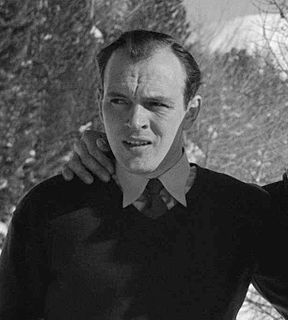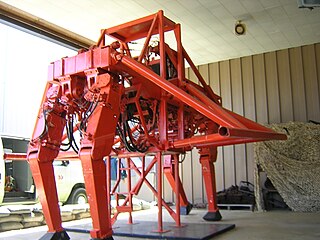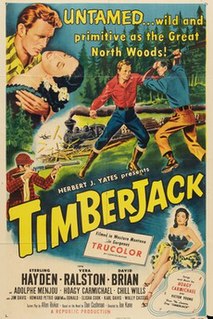The term mecha may refer to both scientific ideas and science fiction genres that center on giant robots or machines controlled by people. Mechas are typically depicted as humanoid mobile robots.

Charley Frank Pride is an American country music singer, musician, guitarist, recording artist, performer, business owner, and former baseball player. His greatest musical success came in the early to mid-1970s, when he became the best-selling performer for RCA Records since Elvis Presley. During the peak years of his recording career (1966–87), he garnered 52 top-10 hits on the Billboard Hot Country Songs chart, 40 of which made it to number one.

A forwarder is a forestry vehicle that carries big felled logs from the stump to a roadside landing. Unlike a skidder, a forwarder carries logs clear of the ground, which can reduce soil impacts but tends to limit the size of the logs it can move. Forwarders are typically employed together with harvesters in cut-to-length logging operations.
Black Widow were a rock band that formed in Leicester, England in September 1969. The band were mostly known for their early use of satanic and occult imagery in their music and stage act. They were often compared with the better-known heavy metal band Black Sabbath, though these bands were only superficially similar.
Richard van Enger was an American film editor who made his debut as an assistant on Gone with the Wind in 1939. Up until his retirement in 1976, he worked on a myriad of projects - mainly B movies - before moving to television in the 1950s where he worked on such shows as Bonanza, The High Chaparral and Alias Smith and Jones. He received an Academy Award nomination for his work on the John Wayne flagwaver Sands of Iwo Jima in 1949.

Vera Ralston was a Czech figure skater and actress. She later became a naturalized American citizen. She worked as an actress during the 1940s and 1950s.

Krång Erik Gunnar Eriksson was a Swedish cross-country skier who won two medals at the 1948 Winter Olympics, a gold in the 4×10 km relay and a bronze in the individual 18 km. Eriksson won the 50 km event at the 1950 FIS Nordic World Ski Championships, but finished 12th at the 1952 Olympics and 21st at the 1954 World Championships.

Jasper Joseph Inman Kane was an American film director, film producer, film editor and screenwriter. He is best known for his extensive directorship and focus on Western films.

Violent Saturday is a 1955 American film noir crime film directed by Richard Fleischer and starring Victor Mature, Richard Egan and Stephen McNally. The film, set in a mining town, depicts the planning of a bank robbery as the nexus in the personal lives of several townspeople.

Book of Dragons is a computer-animated/2D-animated short film based on the How to Train Your Dragon franchise. It was produced by DreamWorks Animation and directed by Steve Hickner. The short was released on November 15, 2011, on DVD and Blu-ray, along with Gift of the Night Fury, another short film based on the Dragons.
The Southern Oregon Timberjacks were a minor league baseball team in the northwest United States, based in Medford, Oregon. The team played in the short-season Class A Northwest League and were an affiliate of the Oakland Athletics for 21 seasons. They played their home games at Miles Field in south Medford from 1979 through 1999.

Miles Field was a baseball park in the northwest United States, located in Medford, Oregon, It hosted high school, American Legion, and minor league teams from 1948 to 2004.
A lumberjack is a worker in the logging industry.

Harry & David Field is a baseball park in the northwest United States, located in Medford, Oregon.
The Way to the Gold is a 1957 drama film directed by Robert D. Webb and starring Jeffrey Hunter, Sheree North, and Barry Sullivan. It was released by 20th Century-Fox.

The Wausau Lumberjacks were a minor league baseball team based in Wausau, Wisconsin that existed on-and-off from 1905 to 1957. The Wausau franchise then became the Wausau Timbers before relocating to become today's Kane County Cougars. The Lumberjacks played in the Wisconsin State League, Wisconsin–Illinois League, Minnesota–Wisconsin League (1909–1911) and Northern League.
The Missoula Timberjacks represented Missoula, Montana, in the Pioneer League from 1956 to 1960. Their best season was 1958 when they went 70-59 under manager Jack McKeon and had Jim Kaat on the roster.

A walking vehicle is a vehicle that moves on legs rather than wheels or tracks. Walking vehicles have been constructed with anywhere from one to more than eight legs. They are classified according to the number of legs with common configurations being one leg, two legs (biped), four legs (quadruped), and six legs (hexapod).











